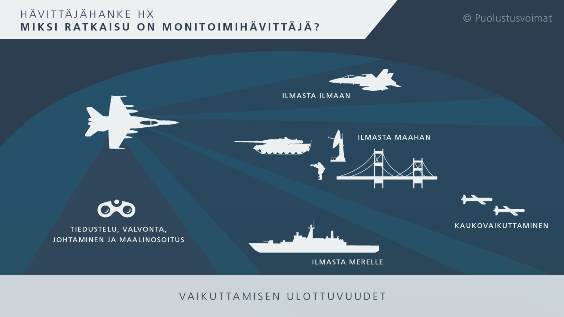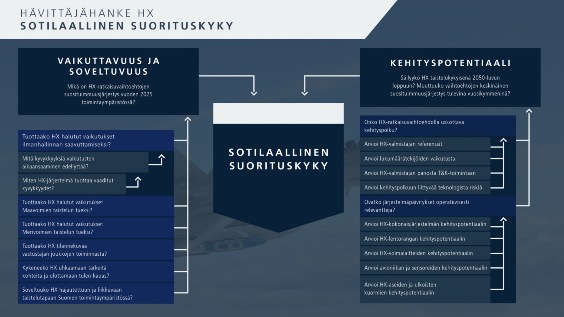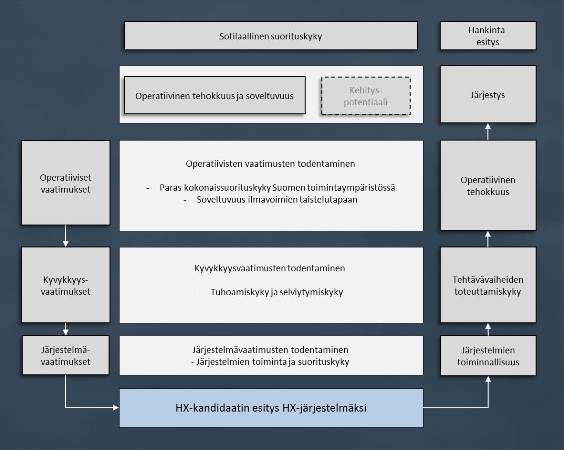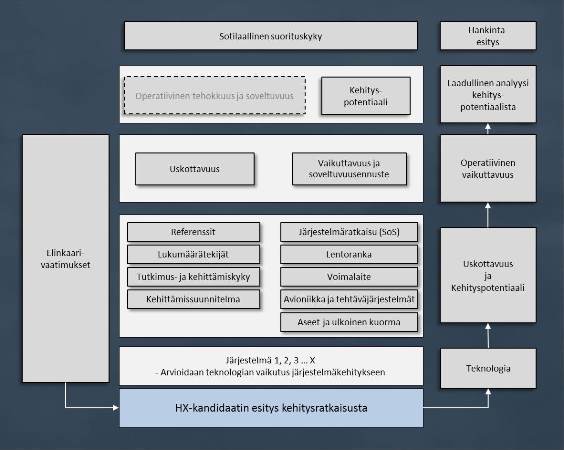Capability assessment finds a multirole fighter suitable for Finland’s defence
The HX Fighter Programme to find a replacement for the capability of the Air Force Hornet multirole fighter advanced to a stage at the end of April in which Requests for Quotation for a comprehensive solution that would best suit Finland’s operational circumstances and defence system were sent to five companies manufacturing fighters. The Leader of the HX Programme, Colonel Juha-Pekka Keränen tells us about a model used for assessing the capability of a comprehensive solution based on a new multirole fighter system in operations of Finland’s defence.
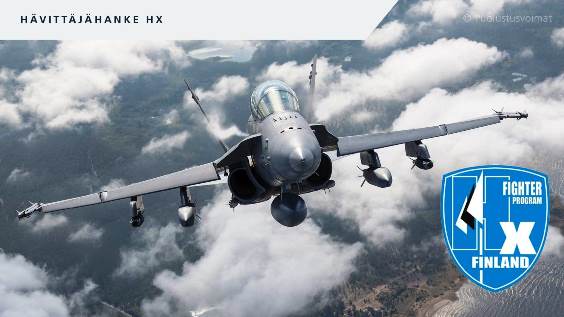
The objective of the HX Programme is to replace the Air Force F/A-18C/D Hornet fleet that is to be phased out during 2025-2030 by a comprehensive solution based on a multirole fighter.
“The Gripen is an affordable state-of-the art multirole fighter- or is it not quite there yet and too small?”
“The Rafale is a total package with a lot of wartime experience under its belt - or is it just a one-of-a kind “French pearl”?”
“The Eurofighter is an efficient multirole fighter in operation in a number of countries - or is it just an expensive project stretching far into the future with very limited operation time?”
“The Super Hornet is the Finnish Air Force’s efficient old acquaintance - or is it just the United States Navy’s interim project outdated at its birth?”
“The F-35 is a capable aircraft and will lead the way in the future - or is it too expensive to operate? Doesn’t it carry enough weaponry?”
These statements come up over and over again in the public debate about the replacement for the Air Force Hornet multirole fighter. Now that the Requests for Quotation concerning the HX have been sent, each candidate is bound to speak for the excellence of their solution with all means possible not only in their responses to the requests but in public as well.
The objective of the HX Programme is to find the multirole fighter solution the best suited for Finland’s circumstances and needs for the replacement of the Hornet fleet to be phased out in 2025-2030.
The Programme was launched in 2015, and a Request for Information (RFI) sent in spring 2016 to the Governments of Great Britain, France, Sweden and the United States has generated responses from five manufacturers of fighters established in these states, and they have now received a Request for Quotation.
The preliminary Request for Quotation sent in April 2018 launched the first negotiation phase of the competitive tender concerning the fighter procurement during which preliminary candidate-specific procurement packages will be determined. During the latter half of 2019 a Request for Quotation for more precise information will be sent. After this, in the second negotiation phase, the final contents of the procurement packages will be determined with each candidate. In 2020, to conclude the second phase, final quotations will be requested. The Finnish Government will make a decision concerning the procurement in 2021.
Since the information to be obtained from the HX candidates is in the domain of either business or security secrets, the defence administration will not make public comments on the candidates or their mutual ranking.
Still, this much can be said: the polemic statements about the HX candidates at the beginning of this article are not true at all. Each candidate is engaged in this competition 100 %, each one of them can offer Finland its respective capability solution and each one of them has also proven to be capable of developing its system to respond to any challenges in the battle field of the future.
Whether a candidate’s capability solution meets our requirements or not will be assessed in the HX Programme Request for Quotation analysis stage that just set off in a manner that I am about to describe.
Bottom to top optimisation model
The decision-making model of the HX Programme has been designed for assessing which comprehensive solution package tendered in the multirole fighter procurement competition would be the best suited for Finland’s conditions and needs. The application of the bottom to top optimisation model means that we do not need to determine weight factors for the different areas of the procurement as is done in traditional multi-criteria analysis or assign values to factors independently of each other.
The aim of the decision-making model is to come up with an optimal total package with each HX candidate in cooperation with the aircraft manufacturer. In other words, in the phase following the sending of the Requests for Quotation we strive to negotiate and build the Gripen, Rafale, Eurofighter, Super Hornet and F-35 solution the best suited for Finland. The decision-making model strives to come up with the best comprehensive solution from the perspective of five decision-making areas, namely security of supply, life cycle costs, industrial participation and military capability, and on the basis of the security and defence policy assessment conducted under the Ministry of Defence.
The HX Programme decision-making model is a so-called bottom to top optimisation model. The objective of the decision-making process is to come up with an optimal comprehensive package with the candidates involved in the HX competition based on a multirole fighter solution suitable for Finland’s circumstances (click the picture to make it larger in a new window).
Defining the HX system
Defining the HX system is the first phase in the two-year negotiation process set off when the Requests for Quotation were sent. The process involves negotiating a supplier-specific procurement package with each candidate.
On level 1 of the decision-making model, each tenderer presents in its quotation its views on the makeup of the HX system structure and the solution the best suited for Finland. The system structure offered in the negotiation phases will gain precision and, as necessary, be worked to the best possible capability the tenderer can offer. Weaponry, special equipment and sensors may be incorporated in the HX package under procurement, but they are manufactured by companies other than the selected aircraft tenderer.
Aircraft tenderers are obligated to form combinations with companies manufacturing weapons and sensors. The responsibility for integrating these systems, i.e. the realisation and verification of their interoperability with the aircraft is expected to lie with the tenderer of the multirole fighter.
Negotiations and the fine tuning of the fighter tender package will continue until the summer of 2020, after which the aircraft companies tendering for the HX competition will submit their final tender. At this point, we will possess all the information concerning all the elements of each candidate’s procurement package including all systems, devices, associated information, tender-provided maintenance and training solutions, and the makeup of the contract package.
Security of supply
Level 2 of the decision-making model, security of supply, involves an analysis to make sure that the Finnish Defence Forces will be able to conduct any air operations required in exceptional circumstances also in situations where communication with the main operator or supply transports to Finland are disabled.
The objective is to negotiate a maintenance and training system which would enable operations in exceptional circumstances while being in normal circumstances a package as cost effective as possible, meeting the requirements of the Air Force quality system. The capability of maintaining systems critical for Finland’s sovereignty must remain in Finland. This requires good technological knowhow, system life cycle management, in other words, a domestic planning organisation, and an integration, overhaul, maintenance, and damage repair capability available in Finland in any circumstances.
Level 2 is where cost optimisation is considered for the first time. If an HX candidate is able to provide a maintenance and training system meeting the Defence Forces’ requirements at a lower price than the others, it could allocate more resources either to increasing military capability or decreasing maintenance costs. Increasing capability would translate, for example, into additional input into the quality and quantity of the multirole fighter’s weaponry, sensors and countermeasure systems.
As for maintenance costs, the tenderer could, for example, decide to increase the number of spare parts or replacement equipment in its total package.
Lifecycle costs
Lifecycle costs make up the third decision-making level. This level involves an analysis of the makeup of the costs that the HX comprehensive solution would entail.
The task is clear: the amount of money appropriated for the procurement, 7-10 billion euros which is the basis for planning, has to cover the aircraft, weapons, sensors and other special and support systems, training and maintenance systems including manuals and the training required for launching activities. After this, additional funding may not be asked for; the operating and maintenance costs of the service life of the HX package extending to the 2060s will have to be covered from the defence administration’s annual budget.
As concerns procurement costs, the price of the comprehensive solution packages obtained on the previous levels of the procurement steps, namely the HX system definition and security and supply levels, are assessed with each HX tenderer.
The maintenance system and in particular, the quantity and quality of weapons, sensors and special systems will impact the procurement price significantly.
In the final assessment the HX candidate cannot advance to the next level before it meets the requirements set for costs.
The life cycle costs are compared against the annual maintenance costs of the Hornet system and the resources used for developing the fleet during its life cycle. The following cost factors are known: the number of the personnel of the Air Force and the Air Systems Division of the Defence Forces Logistics Command, the operating costs of air activities and associated command and control systems, those involved in force production (conscript training), renting real estate and other indirect costs. The comparison also includes services purchased by the Defence Forces from its strategic partners. These include, for example, fees paid to Finavia which maintains Finland’s airports and those paid to air traffic control service provider ANS Finland for the Defence Forces’ air traffic. The evaluation also takes into account that prices of defence material have increased faster than prices in general.
The factors affecting the assessment of life cycle costs in the HX programme are based on the Defence Forces’ data on the costs of the Hornet fleet (click the picture to make it larger in a new window).
In our calculation model, the most important comparison value as regards the maintenance solution is the annual maintenance cost of the multirole fighter fleet (life cycle cost model item 5.), that is often presented in a simplified manner as cost in euros per flight hour. It is possible to make such a comparison per the Hornet’s annual costs that have been able to be documented and verified with precision, for example, with software used for calculating the costs of the HX programme.
Other costs presented in the life cycle model (items 1.-4. and 6.-8.) are assessed by the Air Force Command using the Life Cycle Cost (LCC) calculation model based on the cost information produced by the Defence Forces Logistics Command. The analysis is made by using an information model used in the Defence Forces which includes the following items: mode of operations of troops conducting tasks set for the HX system, set up of organisation, training and exercise system, materiel procurements, personnel, leadership and leadership training required for the activities, provision of support and facilities, and interoperability and information.
In order to minimise maintenance and development costs in the fighter solution procurement and in the development during its life cycle, the objective is to gain maximal operational and technical compatibility with the main operator or main operators of the multirole fighter.
The primary operator is often the state in which the system was developed or an alliance of states including their armed forces. In order to develop capability, operational user groups and user groups examining future capabilities have often been constituted among developer and user states and aircraft manufacturers.
Operational user groups generally focus on how to rapidly improve the capability of a multirole fighter. Future development groups focus on what type of improvements might be needed in the future. Both groups set requirements and, depending on the development budget, these requirements either get included or not in development programmes.
Each HX candidate has its own development programme, and the tenderers intend to keep their aircraft combat capable in the future as well. The task of the HX Programme is to examine the nature, price and credibility of the candidates’ development programmes. At the same time, the strategic planning of the Defence Forces also strives to find out what the share of the Air Force and the HX package would be out of the total amount of money to be appropriated for the development of Finland’s defence system in the decades to come.
Industrial participation
Level 4 of the decision-making model, industrial participation (IP), involves an evaluation of how cooperation between HX tenderers and domestic industry would be realised. Minister of Defence Jussi Niinistö has set an industrial participation obligation for the HX Programme in the amount of 30 per cent minimum of the total contract value.
The Ministry of Defence will be responsible for the evaluation of industrial participation and the networking of domestic industry with HX tenderers. The primary objective of industrial participation is to ensure the military security of supply of defence industry products from Finnish and foreign manufacturers and the availability of critical technology in any circumstances. The secondary objective is to ensure the development of Finnish technology and competence in the future as well.
The HX programme contributes to the building of industrial participation by ensuring that a maintenance, support provision and training solution suited for Finland’s circumstances is planned and negotiated for each candidate in which part of the maintenance capabilities, information or training included in the arrangement would expediently be procured as part of direct industrial participation.
Indirect industrial participation can create capabilities for the defence administration, research and scientific communities and universities. In the evaluation of this participation, special attention is paid to how the knowhow and technology are connected to the capabilities critical for Finland’s defence and to safeguarding their technological and industrial foundation.
Military capability
Level 5 of the decision-making model involves the assessment of the military capability of the HX candidates. This is the only area where the HX candidates are scored and ranked. The military capability requirements set for the HX have been determined as part of the Defence Forces strategic planning process. The objective has been to foresee in a comprehensive manner what kind of requirements the operational environment of the 2030s defence system will set for a multirole fighter.
Military capability requirements are set on three different levels in the HX Request for Quotation.
The HX tenderers are expected to respond to the Request for Quotation with a comprehensive solution which would meet the operational requirements, generate the capabilities needed for operations and meet the conditions set for system requirements.
The highest level provides a description of the life cycle and operational capability requirements set for the HX system as part of the defence system. The HX Request for Quotation sets six top-level capability requirements for assessing the candidates’ capability.
These capability requirements involve five scenarios, and the HX system must be able to conduct air operations involving these scenarios. These scenarios include counter air (air defence), counter land (air to ground), counter sea (air to sea), intelligence, surveillance and reconnaissance (ISR) and targeting, and long-range strike.
Out of these five scenarios, counter air is the most critical one and therefore takes precedence. Counter air is where a candidate’s capability to perform in combats both with fighters and ground based air defence is evaluated. This is a critical capability: the HX multirole fighter may get engaged in air combat or be attacked by ground based air defence in addition to other tasks. Provision of support also plays an important role in the evaluation even if it is not given independent weight. In terms of operations, the flexibility and capability of support provision contribute to the results of each scenario.
Requirements have been placed on the HX system also as regards the fleet’s support system. The HX will have to be able to implement the Air Force’s agile air warfare from dispersed air bases with varying levels of equipment and forward operating bases within the range of enemy long-range strike.
The seventh criterion is a life cycle requirement according to which the new multirole fighter is expected to be operational for a minimum of 30 years.
Operational requirements are assessed in scenarios describing military crisis situations and tasks set for multirole fighters specifically drawn up for the Request for Quotation. In their responses to the request, the HX candidates aim at achieving the end results required in the scenarios by producing desired impacts with selected solutions.
Capability requirements have been set for the HX Programme involving five scenarios. The type of air defence scenarios which the new multirole fighter will have to be able to carry out include counter air, counter land requiring air-to-ground weapon effect, air-to-sea, intelligence, surveillance and reconnaissance and targeting operations, and long-range strikes operations. The HX fleet will have to be able to conduct agile combat from dispersed locations (click the picture to make it larger in a new window).
Military capabilities requirements, level 2, sets the types of requirements that are anticipated to be needed in air operations in the 2030s. The Request for Quotation includes about 200 such capability requirements.
Level 3 describes the system requirements set for the HX using a data model used in the Defence Forces. The system requirements - 200 in total involving military capability - involve restrictions and conditions set for the HX solution which aim at ensuring that the system will be able to be integrated into the Finnish defence system. Another objective is to collect enough information about the operation of the systems of the HX candidates to allow decision-making.
Capability and system requirements have been set only a few critical minimum values or conditions that the HX candidates are expected to meet. The objective of requirements (other than these) is to provide guidance to the candidates for drawing up of their quotations and to support the HX programme in building a comprehensive package the best suited for serving the needs of the Finnish defence system.
Evaluation of military capability
The evaluation of the military capability of the HX candidates is based on the requirements set in the Request for Quotation. The final evaluation between the candidates will be done with regard to two areas, namely operational capabilities (effectiveness and suitability) and future development potential. The Defence Forces will give a selection recommendation from the military capability standpoint on the basis of the qualitative and quantitative evaluations achieved by using the decision-making model.
The assessment of the military capability of the HX candidates involves the effectiveness of the fighter candidates and their suitability for conducting operations in Finland’s operational environment including all of their separate stages. In addition, the candidates’ potential for future development is assessed. For layout technical reasons, the picture shows the chaining up of the assessment process only as concerns the first operational requirement. (Click the picture to make it larger in a new window.)
Effectiveness and suitability describes how well each HX candidate performs assigned tasks in Finland’s operational environment. It scores the fulfilment of operational requirements through capability and system assessments. Tendered HX solutions are assessed by looking at how well the candidates meet the operational requirements when performing interlinked tasks that make up scenarios. The analysis measures performance throughout operations including in their separate stages instead of verifying whether an individual requirement is met.
The decision-making area of development potential serves as a sensitivity analysis tool in the final overall evaluation. It is used to examine whether the ranking between the HX candidates obtained in the area effectiveness and suitability changes when the increase in capability provided for in the candidates’ respective development plans is taken into account.
Evaluation of effectiveness and suitability
Evaluation of effectiveness and suitability is conducted in three phases proceeding from details to entities. First, a system assessment is made, second, a capability assessment and third, an operational assessment. The methods used for verifying capability include, for example, comparison of the candidates’ responses to the Request for Quotation, classification of the information provided, modelling and simulation, simulator flights and flight tests.
Evaluation of effectiveness
System evaluation involves examining the operation of the systems of the candidates’ HX solutions and verifying that critical system requirements are met. The objective is to understand the system solution of each HX candidate. This system analysis bases on the candidates’ responses to the Request for Quotation. Incomplete or conflicting system data will be considered an increased risk at later phases of the analysis, and in uncertain cases the lowest trustworthy value will be referred to as a system’s capability. System assessment produces descriptions of the operation of systems and measured values of their features.
The capability assessment in the second phase is based on the HX candidates’ verified responses to the Request for Quotation and assessments of how well the candidates’ systems meet the capability requirements. The objective is to understand how the various capabilities used by the candidates at different stages of a scenario would contribute to the end result. This evaluation produces performance values against which success can be measured in different stages of a combat including, for example, destruction and survival capability.
The objective of the third phase is to assess the operational level capability of an HX solution to generate the desired impacts in use involving the scenarios in the Request for Quotation. Performance is measured in terms of how well the candidate meets the operational requirements with a view of finding the best comprehensive capability verified, for example, by generated impacts, resources used and survivability, flexibility, ability to share situation awareness and presence.
Evaluation of suitability
The suitability and flexibility of the support concept of an HX solution is assessed in dispersed activities in a scenario created for this purpose. Values for operational level suitability include, for example, ability to generate sorties in different circumstances, mission capability, ability to operate from dispersed locations, performance values during takeoff and landing, as well as mission briefing, debriefing and reporting.
Operational war game in the evaluation of effectiveness and suitability
As soon as the scenarios and support scenarios have been verified, the next step is to assess the actual operational capability of the HX candidates in Finland’s operational environment. This is assessed by keeping up in a prolonged manner the situations included in the normal and exceptional circumstances scenarios described in the Request for Quotation using a war game which simulates operational activities. The objective is to assess the capability of the HX tenderers’ comprehensive solutions to perform in these scenarios through a chain of events taking several sorties.
The capability of an HX solution to respond to the challenges faced by it in different stages of the war game is based on information obtained at earlier phases involving its capability to respond to various types of threats.
For example, the turnover time of flight packages - the time it takes to refuel and weapons reload - and its impact on operation tempo is based on the information obtained from the assessment of a candidate’s support concept. The capability to survive in air combats is based on success in counter air operations at earlier stages.
To put it simply, no matter how well an HX candidate performs in the air, but cannot engage in combat due to slow operation tempo, its combat value remains low. Of course, the same is true if the operation tempo is fast, but it does not perform well in the air.
In operational level assessment, focus is placed not only on verifying that the requirements are met, but also on factors such as passive protection, tactical and operational flexibility, operating from dispersed locations and a capability to take on different roles during the same mission (Swing Role).
The HX candidates are assessed in terms of effectiveness and suitability in three phases proceeding from details to entities. The first phase involves a system assessment, the second phase a capability assessment, and the third phase an operational assessment. The objective is to examine the capability of the systems of the HX candidates and the operational potential of the fighter candidates, and to test how well the whole package would work in normal and exceptional circumstances in Finland’s conditions using simulated war game scenarios. (Click the picture to make it larger in a new window.)
Evaluation of development potential
The assessment of development potential provides a qualitative and quantitative estimate of an HX solution’s capacity to remain combat capable until the end of the 2050s as well as an estimate of any relative changes between HX solutions compared with the results of the capability assessment. The main criteria for assessing development potential are credibility and prediction for effectiveness and suitability.
The assessment of credibility provides a description of the credibility of an HX candidate’s development path. Sub-criteria concerning credibility include the manufacturer’s prior performance, factors relating to operators and numbers of aircraft, identified development path and the manufacturer’s technological capabilities of realising the development program. The assessment produces values for measuring the development path in terms of credibility. These include, for example, aircraft production timeframes and quantities, the performance of the manufacturer in its earlier aircraft projects, critical technologies involving upgrades and their technological maturity and Finland’s possibilities of influencing the contents of future equipment upgrades.
The effectiveness and suitability prediction criterion assesses the importance of planned HX system upgrades in the operational environment in the future. The assessment looks at the relative increase in capability brought about by system upgrades vis-à-vis changes in the operational environment. System level assessment produces values which describe system upgradability and growth potential. These include, for example, assessments on restrictions and potential involving the airframe and power plants, avionics and sensor upgrades and integration of external payloads. System level descriptions are used as baseline data for determining sub criteria values and assessing the strengths and weaknesses of future capability.
The process evaluating the capability of the HX solution options examines not only the operational capability of the multirole fighter candidates, but also the development and maintenance potential of a fighter solution over 30 years of service. (Click the picture to make it larger in a new window.)
In conclusion
The objective of the HX fighter programme is to produce an analytical final report which will disclose the Defence Forces’ well-founded proposal for a new HX multirole fighter and HX comprehensive solution.
The HX programme is a comprehensive and interesting project which respects the confidential information received from the HX tenderers and appreciates their financial investments in this demanding project.
At a general level, the purpose of this article is to describe how the HX programme approaches the assessment task and how the capability assessment is conducted. As the complex set of assessment criteria shows, ranking the candidates involved in the HX programme from the standpoint of Finland’s air defence operations is not quite as simple as public debate lets one assume. The HX programme assesses the candidates as solution packages, and its objective is to find the best comprehensive solution for the needs of Finland’s defence system in the 2030s- 2060s. This requires a careful analysis of all the decision-making areas involving the HX comprehensive solution and cooperation with the five aircraft manufacturers offering their products.
Colonel Juha-Pekka Keränen
HX Programme Director
Finnish Air Force



